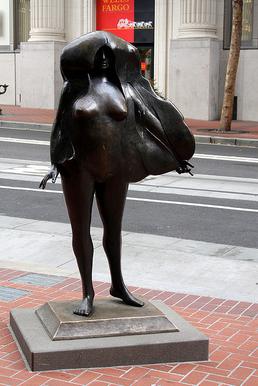
The Metropolitan Area Express (MAX) is a light rail system serving the Portland metropolitan area in the U.S. state of Oregon. Owned and operated by TriMet, it consists of five lines connecting the six sections of Portland; the communities of Beaverton, Clackamas, Gresham, Hillsboro, Milwaukie, and Oak Grove; and Portland International Airport to Portland City Center. Trains run seven days a week with headways of between 30 minutes off-peak and three minutes during rush hours. In 2019, MAX had an average daily ridership of 120,900, or 38.8 million annually. Due to the COVID-19 pandemic, which impacted public transit use globally, annual ridership plummeted, with only 14.8 million riders recorded in 2021.

The MAX Yellow Line is a light rail line serving Portland, Oregon, United States. Operated by TriMet as part of the MAX Light Rail system, it connects North Portland, Portland City Center, and Portland State University (PSU). The line serves 17 stations; it runs north–south from Expo Center station to PSU South/Southwest 6th and College station, interlining with the Green and Orange lines within the Portland Transit Mall. Service runs for 21 hours per day with headways of up to 15 minutes. The Yellow Line is the fourth-busiest service in the MAX system; it carried an average 12,960 riders per weekday in September 2019.

Pioneer Square South and Pioneer Square North are a pair of light rail stations in Portland, Oregon, United States, served by TriMet as part of the MAX Light Rail system. Situated directly west of the Portland Transit Mall at Pioneer Courthouse Square in downtown Portland, they occupy the sidewalk on Yamhill and Morrison streets between Broadway and 6th Avenue. The stations consist of one side platform each; trains traveling eastbound stop at Pioneer Square South while trains traveling westbound stop at Pioneer Square North.

Like transportation in the rest of the United States, the primary mode of local transportation in Portland, Oregon is the automobile. Metro, the metropolitan area's regional government, has a regional master plan in which transit-oriented development plays a major role. This approach, part of the new urbanism, promotes mixed-use and high-density development around light rail stops and transit centers, and the investment of the metropolitan area's share of federal tax dollars into multiple modes of transportation. In the United States, this focus is atypical in an era when automobile use led many areas to neglect their core cities in favor of development along interstate highways, in suburbs, and satellite cities.
Portland is "an international pioneer in transit orientated developments."

The MAX Green Line is a light rail service in Portland, Oregon, United States, operated by TriMet as part of the MAX Light Rail system. It is 15 miles (24.1 km) long and serves 30 stations from the PSU South stations to Clackamas Town Center Transit Center; it connects Portland State University (PSU), Portland City Center, Northeast Portland, Southeast Portland, and Clackamas. The Green Line is the only service that shares parts of its route with the four other MAX services, sharing the Portland Transit Mall with the Orange and Yellow lines and the Banfield segment of the Eastside MAX with the Blue and Red lines. Southbound from Gateway/Northeast 99th Avenue Transit Center, it operates the Interstate 205 (I-205) segment through to Clackamas Town Center. Service runs for approximately 211⁄2 hours daily with a headway of 15 minutes during most of the day. It is the third-busiest line in the system, carrying an average of 19,160 riders per day on weekdays in September 2019.
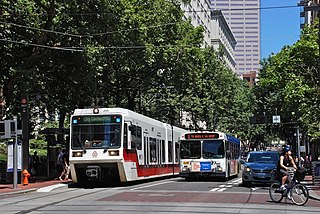
The Portland Transit Mall is a 1.2-mile (1.9 km) public transit corridor that travels north–south through the center of downtown in Portland, Oregon, United States. It comprises a pair of one-way streets—6th Avenue for northbound traffic and 5th Avenue for southbound—along which two of three lanes are restricted to transit buses and light rail vehicles only. As of September 2022, the corridor is served by the Green, Orange, and Yellow lines of MAX Light Rail; Frequent Express; and over a dozen local bus routes, all of which are services of TriMet, the transit agency operating within the Oregon side of the Portland metropolitan area. C-Tran, the transit agency for Clark County, Washington, additionally serves it with two express bus routes—#105 I-5 Express and #164 Fisher’s Landing Express.
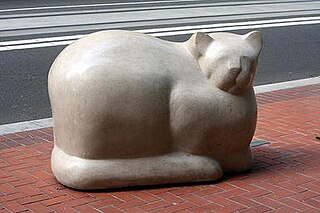
Cat in Repose, also known as Seated Cat, is a stone sculpture composed of Indiana Limestone, located on the Transit Mall of downtown Portland, Oregon, United States. Designed and created by Kathleen McCullough in 1977, the sculpture is currently installed near the intersection of Southwest Fifth Avenue and Southwest Morrison Street. Cat in Repose is part of the City of Portland and Multnomah County Public Art Collection courtesy of the Regional Arts & Culture Council.

Allow Me, also known as Umbrella Man, is a 1983 bronze sculpture by John Seward Johnson II, located in Pioneer Courthouse Square in Portland, Oregon, United States. The sculpture, one of seven Allow Me casts, was donated anonymously to the City of Portland in 1984 for display in the Square. It depicts a life-sized man dressed in a business suit, hailing a cab and holding an umbrella. Constructed from bronze, aluminum and stainless steel, the sculpture stands six feet, ten inches tall and weighs 460 pounds. The sculpture is one of many works of art generated by the city's Percent for Art program, and is considered part of the City of Portland and Multnomah County Public Art Collection courtesy of the Regional Arts & Culture Council.

Shemanski Fountain, also known as Rebecca at the Well, is an outdoor fountain with a bronze sculpture, located in the South Park Blocks of downtown Portland, Oregon, in the United States. The sandstone fountain was designed in 1925, completed in 1926, and named after Joseph Shemanski, a Polish immigrant and businessman who gave it to the city. Carl L. Linde designed the trefoil, which features a statue designed by Oliver L. Barrett. The sculpture, which was added to the fountain in 1928, depicts the biblical personage Rebecca. Shemanski Fountain includes two drinking platforms with three basins each, with one platform intended for use by dogs.

Nepenthes is a series of four sculptures by artist Dan Corson, installed in 2013 along Northwest Davis Street in the Old Town Chinatown neighborhood of Portland, Oregon, in the United States. The work was inspired by the genus of carnivorous plants of the same name, known as tropical pitcher plants. The sculptures are 17 feet (5.2 m) tall and glow in the dark due to photovoltaics.

Thompson Elk Fountain, also known as the David P. Thompson Fountain, David P. Thompson Monument, Elk Fountain, the Thompson Elk, or simply Elk, was a historic fountain and bronze sculpture by American artist Roland Hinton Perry. The fountain with its statue was donated to the city of Portland, Oregon, United States, in 1900 for display in Downtown Portland's Plaza Blocks. It was owned by the City of Portland.

The Spanish–American War Soldier's Monument, also known as the Spanish–American War Memorial or simply Soldiers Monument, is an outdoor sculpture and war memorial monument honoring the dead of the 2nd Oregon Volunteer Infantry Regiment of the Spanish–American War and Philippine–American War. The monument was created by American artist Douglas Tilden and located in Lownsdale Square, in the Plaza Blocks of downtown Portland, Oregon. It features a bronze statue on a marble pedestal and granite base. The monument is part of the City of Portland and Multnomah County Public Art Collection courtesy of the Regional Arts & Culture Council.
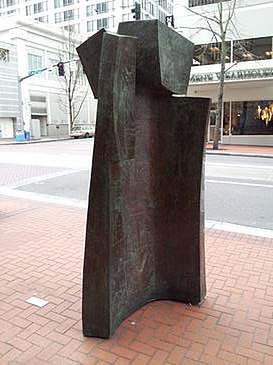
Thor is an outdoor 1977 copper and redwood sculpture by American artist Melvin Schuler, located on the Transit Mall of downtown Portland, Oregon.

Talos No. 2 is an outdoor 1959–1977 bronze sculpture created by the American artist James Lee Hansen. It is located in the Transit Mall of downtown Portland, Oregon, in the United States.

Winter Rider No. 2, also known as Winter Rider Variation, is an outdoor bronze sculpture by American artist James Lee Hansen, located on the Transit Mall of downtown Portland, Oregon.

Running Horses is an outdoor 1986 bronze sculpture by Tom Hardy, located on the Transit Mall in downtown Portland, Oregon. It is part of the City of Portland and Multnomah County Public Art Collection courtesy of the Regional Arts & Culture Council.
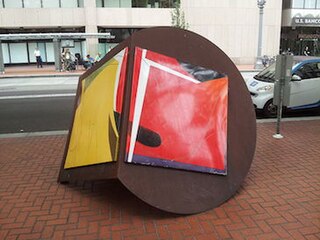
Untitled is an outdoor 1977 steel and porcelain enamel sculpture by American artist John Killmaster, located in downtown Portland, Oregon. It is part of the City of Portland and Multnomah County Public Art Collection courtesy of the Regional Arts & Culture Council.

Driver's Seat is a 1994 galvanized steel sculpture by Don Merkt, installed along the Transit Mall in Portland, Oregon's Old Town Chinatown neighborhood, in the United States. The artwork was funded by the City of Portland's Percent for Art program, the Portland Development Commission, and TriMet, and remains part of the City of Portland and Multnomah County Public Art Collection courtesy of the Regional Arts & Culture Council.

City Reflections is an outdoor 2009 bronze sculpture by Patti Warashina, located in downtown Portland, Oregon.

Urban Hydrology is a series of twelve outdoor 2009 granite sculpture by Fernanda D'Agostino, installed along the Portland Transit Mall in Portland, Oregon, United States. The work is part of the City of Portland and Multnomah County Public Art Collection courtesy of the Regional Arts & Culture Council, which administers the work.
